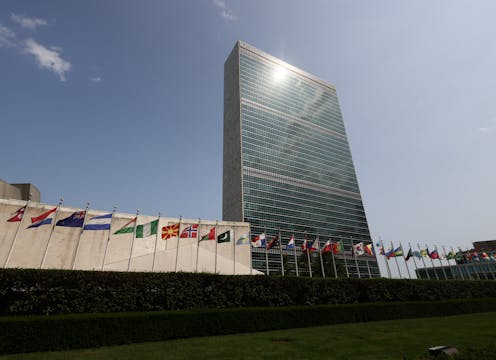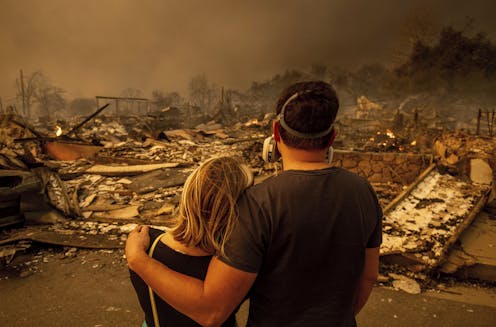The US ambassador to the UN is tasked with doing a careful dance between Washington and the world
- Written by Abiodun Williams, Professor of International Politics, Tufts University

New York Rep. Elise Stefanik, a Republican, is set to testify before the Senate Foreign Relations Committee on Jan. 16, 2025, as part of her confirmation process to become the next U.S. ambassador[1] to the United Nations.
International diplomacy[2] is the essence of the U.N. As a former United Nations official and an academic[3] who has published widely on the U.N., I know that diplomacy is an art, not a science.
And a good ambassador can make a real difference.
A direct line from the UN to the president
The alliances countries form and maintain at the U.N. are necessary to help confront global crises that exceed the reach and power of any single nation.
All of the 193 governments that make up the U.N. have ambassadors who negotiate different U.N. agreements on issues ranging from terrorism to nuclear proliferation[5].
Of all these ambassadors, the U.S. envoy is a particularly high-profile and unique job. First, the U.S. is the host country to the U.N. headquarters. The U.S. is also the U.N.’s largest financial contributor[6].
Some U.S. ambassadors have been career diplomats, like Linda Thomas-Greenfield[7], the current ambassador who was appointed by President Joe Biden in February 2021.
Other former U.S. ambassadors to the U.N. have backgrounds in other areas, including academia[8], journalism[9] and U.S. politics[10].
The U.S. ambassador can be part of a president’s Cabinet and report directly to the president, or may not have the Cabinet rank and instead report to the secretary of state. Nikki Haley[11], who served as ambassador to the U.N. during the first Trump administration, had Cabinet status, as would Stefanik, assuming she is confirmed.
Having the ear of the president strengthens the ambassador’s influence at the U.N.
The ambassador’s top jobs
The U.S. ambassador serves as an effective international advocate for the government’s interests, be it on reducing food insecurity and preventing famine[12] in other countries or trying to stop North Korea from launching ballistic missiles[13].
The ambassador explains the U.S. government’s particular positions to other countries’ ambassadors and representatives at the U.N.
The U.S. ambassador also listens to foreign representatives about their political positions. The ambassador then acts as a bridge between the U.N. in New York and the U.S. government in Washington, navigating difficult conversations on human rights and terrorism, for example.
The ambassador’s third, day-to-day role involves overseeing the 150 State Department and other staff at the U.S. mission to the U.N.[14], a building right across the street from U.N. headquarters on First Avenue in Manhattan.
The U.S. mission’s employees do everything from negotiating Security Council resolutions to advising the ambassador and other top offices on media relations.
The U.S. ambassador is also heavily involved in selecting the U.N. secretary-general, who leads the organization in its varied political and humanitarian work over a five-year term.
Countries can nominate particular candidates to serve as the secretary-general. But any candidate must be able to win the support of the U.S. and the other Security Council permanent members, which have the power to shoot down and reject a potential U.N. leader.
Countries will next vote to appoint a new secretary-general in 2026.
The UN Security Council
A large part of the U.S. ambassador’s work happens at the Security Council[16], a key part of the U.N. that is tasked with maintaining international peace and security. Since the U.N. was founded in 1945, the Security Council has been almost exclusively crisis and emergency driven.
The council has more power than arguably any other branch of the U.N., since its recommendations and decisions, known as resolutions, are considered binding under international law. The council has voted on sanctions[17] – which could look like travel bans or freezing of international assets – against a range of individuals, countries like Iran and Somalia, and terrorist groups like al-Qaida. It also has the power to authorize U.N. peacekeeping operations to be deployed to conflict zones.
The U.S., China, France, Russia and the United Kingdom are the five permanent members of the council[18]. While other countries rotate and take turns participating in the council’s work, only these permanent council members can veto resolutions – leading to frequent stalemates[19].
In 2024, the U.S. used its veto power five times[20] to reject resolutions related to the war between Israel and Hamas.
The U.S. ambassador can help decide what issues the council discusses, draft and share resolutions, and influence how other council members vote.
Real negotiations occur not in formal meetings that are routinely aired live but in informal consultations[21] behind closed doors. This is where diplomats exercise their ingenuity and settle their differences.
Days after the 9/11 terrorist attacks on the World Trade Center and the Pentagon, U.S. Ambassador John Negroponte[22], an appointee of then-President George W. Bush, negotiated a resolution that called for governments to take on different counterterrorist[23] activities.
Six months after the U.S. Senate confirmed Susan Rice[24] as ambassador in 2009, she led the Security Council in approving a resolution that imposed economic sanctions[25] on North Korea in response to its nuclear and missile tests.
Today, the Security Council is dealing with various conflicts in Africa, Asia, Europe and the Middle East. The council also focuses on counterterrorism, energy, climate, natural resources and other issues.
Making the case
The U.S. ambassador to the U.N. is a public figure who is expected to frequently travel outside of the country to make the case for why the United States’ participation and leadership at the U.N. matters.
This is important because about 40% of Americans[26] in 2023 said that the U.S. does not benefit from being a member of the U.N. And in a democracy, a successful foreign policy approach must have public support.
This story is part of a series of profiles[27] of Cabinet and high-level administration positions.
References
- ^ confirmation process to become the next U.S. ambassador (www.c-span.org)
- ^ International diplomacy (www.cambridge.org)
- ^ academic (fletcher.tufts.edu)
- ^ Allison Robbert-Pool/Getty Images (www.gettyimages.com)
- ^ nuclear proliferation (www.un.org)
- ^ largest financial contributor (betterworldcampaign.org)
- ^ Linda Thomas-Greenfield (usun.usmission.gov)
- ^ including academia (www.britannica.com)
- ^ journalism (www.britannica.com)
- ^ U.S. politics (www.britannica.com)
- ^ Nikki Haley (www.britannica.com)
- ^ preventing famine (usun.usmission.gov)
- ^ launching ballistic missiles (usun.usmission.gov)
- ^ U.S. mission to the U.N. (usun.usmission.gov)
- ^ Michael M. Santiago/Getty Images (www.gettyimages.com)
- ^ Security Council (main.un.org)
- ^ council has voted on sanctions (sumsub.com)
- ^ five permanent members of the council (www.cfr.org)
- ^ frequent stalemates (policy-practice.oxfam.org)
- ^ veto power five times (www.passblue.com)
- ^ informal consultations (main.un.org)
- ^ John Negroponte (www.britannica.com)
- ^ called for governments to take on different counterterrorist (digitallibrary.un.org)
- ^ Susan Rice (www.american.edu)
- ^ approving a resolution that imposed economic sanctions (www.armscontrol.org)
- ^ 40% of Americans (www.pewresearch.org)
- ^ series of profiles (theconversation.com)
Authors: Abiodun Williams, Professor of International Politics, Tufts University




